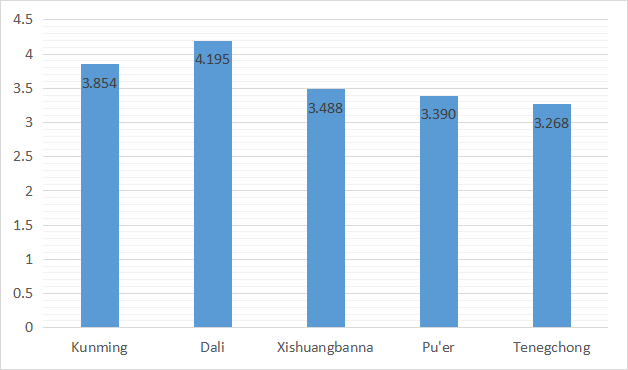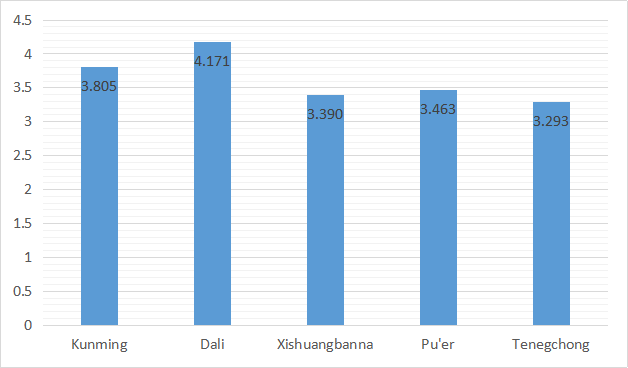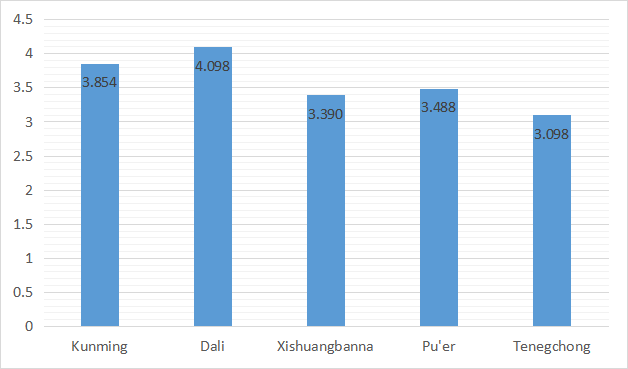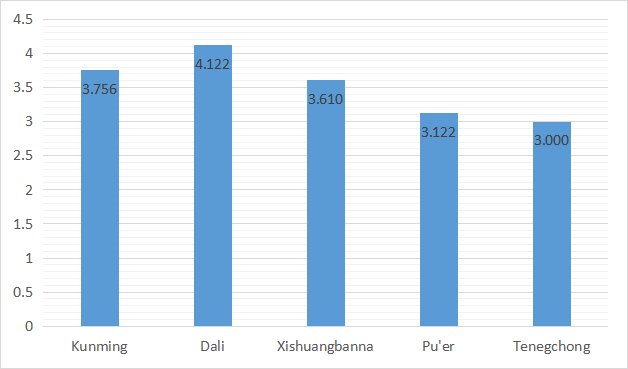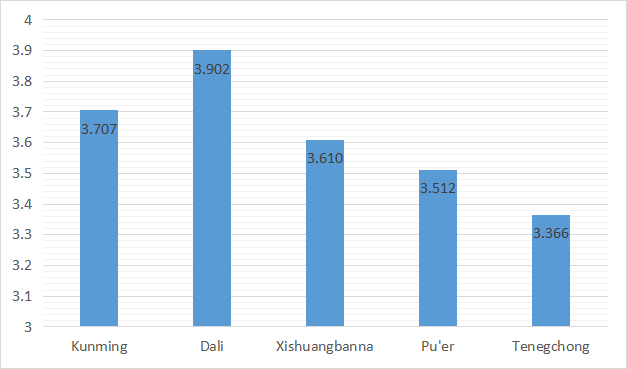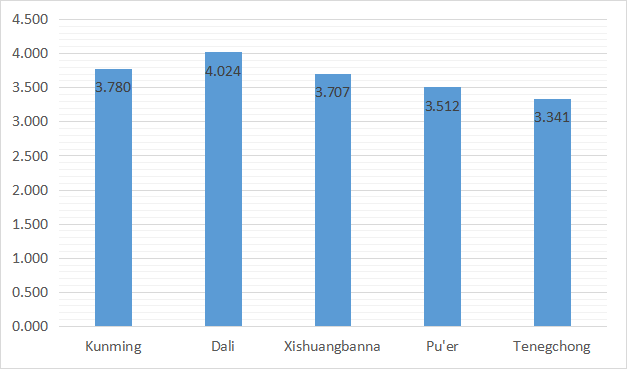云南旅游推介语的英译特征及其跨文化交际效果评析A Study of the Linguistic Characteristics and Intercultural Communication Effectiveness of English Tourism Promotion Slogans in Yunnan Province毕业论文
2020-04-18 20:45:24
摘 要
List of Figures iv
1. Introduction 1
1.1 Research background 1
1.1.1 The Silk Road Economic Belt and the 21st-Century Maritime Silk Road 1
1.1.2 Tourism Industry in Yunnan Province 1
1.2 Need for the study 2
1.3 Structure of the thesis 3
2. Literature Review 4
2.1 The origin of Functional Equivalence Theory 4
2.2 The value of Functional Equivalence Theory 5
2.3 The gap of study of Functional Equivalence Theory 6
3. Methodology 7
3.1 Research questions 7
3.2 Research design 7
3.2.1 Qualitative design 7
3.2.2 Quantitative design 8
3.3 Research Procedures 8
4. Results and Discussion 10
4.1 The linguistic characteristics of English tourism promotion slogans 10
4.1.1 Lexical characteristics 10
4.1.2 Sentence characteristics 14
4.2 The potency of English tourism promotion slogans 15
4.2.1 The slogan of understanding easily and concisely 16
4.2.2 The slogan of catching your attention 17
4.2.3 The slogan of highlighting its value and tourism features 18
4.2.4 The slogan of arousing your curiosity and interest 19
4.2.5 The slogan of driving force 20
4.2.6 The slogan of being trustworthy 21
5. Conclusion 23
References 25
Appendix: Data collection instrument 26
Acknowledgments 30
Abstract
With economic booming and globalization, an increasing number of people from other countries travel to China. English tourism promotion slogans of tourist cities not simply enable visitors to understand the culture and scenery of our tourist destinations, but also promote cross-cultural communication. In the theoretical framework of Eugene Nida’s Functional Equivalence Theory, this study explores linguistic characteristics and potency of English tourism promotion slogans of tourist cities in Yunnan Province, with the combination of qualitative and quantitative research methods. The major findings are as follows:
The first is on lexical characteristics. English tourism promotion slogans in Yunnan are mainly composed of nouns and adjectives. Actually, nouns and adjectives can express a lot of content. Prominent nouns and adjectives can convey the main information of tourist destinations, helping visitors to construct images of tourist attractions and activate their interest of travelling.
The second involves sentence characteristics. English tourism promotion slogans of Yunnan Province have three features: sentences are shorter because they can impress visitors; the use of noun phrase structure can make the form unsophisticated and cushy to recall; simple present tense expresses the consistent features of the tourist city. By analyzing the texts, it can be found that the slogan with good translation quality meets the above three characteristics. In particular, the English tourism promotion slogans in Kunming and Dali fully highlight the above three characteristics.
The third concerns the potency of English tourism promotion slogans. The potency of English tourism promotion slogans in five tourist cities is from high to low, namely, Dali, Kunming, Banna, Pu’er, and Tengchong. Among them, the quality of English tourism promotion slogan in Dali is the best and its potency is the strongest, whereas the quality of English tourism promotion slogan in Tengchong is not comparatively good and ordinarily performs in terms of potency. That is to say, the English tourism promotion slogans with high translation quality have a positive effect on its potency. English tourism promotion slogans with poor translation quality have a negative effect on its potency.
The findings of this study can provide a certain reference for optimizing English tourism promotion slogans in Yunnan and even the whole country and promoting China’s tourism industry. Limitations also exist in this study, such as that the English tourism promotion slogans of the selected five cities cannot fully represent the English tourism promotion slogans of Yunnan Province.
Keywords: Tourism translation, Potency, Linguistic characteristics, English tourism promotion slogans.
中文摘要
随着经济发展和全球化,旅游已经成为人们日常生活中的一种消费方式。旅游城市英语推介语不仅能让游客了解旅游目的地的文化和风景,而且能推动文化传播。本研究以尤金.奈达的功能对等理论为理论框架,采用定性和定量相结合的研究方法,探讨云南省旅游城市推介语英译的语言特征及其效力。研究成果主要包括:
第一,词汇特征。云南省英语旅游推介语主要是由名词和形容词构成。名词和形容词本身就能传达出很多的内容。突显名词和形容词可以更好地传达出旅游目的地的主要信息,帮助游客构建出旅游目的地的形象,激发他们的旅游愿望。
第二,句子特征。云南省英语旅游推介语的句子有三个特征:句子较短,多用名词短语结构和采用一般现在时。句子简短是为了方便游客记忆;采用名词短语结构是因为形式简单便于理解;采用一般现在时是为了表达旅游城市一贯的特征。通过文本分析,可以发现翻译质量较好的推介语都符合上述三个特征,例如昆明和大理的英语旅游推介语。
第三,效力评析。五个旅游城市英语旅游推介语的效力从大到小依次是大理,昆明,版纳,普洱,腾冲。其中,大理的推介语翻译质量好,其效力上最强。腾冲的推介语质量相对较差,其效力一般。换言之,翻译质量较高的英语旅游宣传标语对其效力有积极作用。翻译质量较差的英语旅游宣传标语对其效力有消极作用。
本研究结果对优化云南乃至全国旅游推介语的外译,促进我国旅游业发展有一定借鉴作用。本研究也存在一些不足,所选取的5个城市的英语旅游推介语并不能完全代表整个云南省的英语旅游推介语。
关键词:旅游翻译,推介语效力,推介语英译特征, 英语旅游推介语
List of Figures
Figure 4.1 Proportion of part pf speech in the slogans 11
Figure 4.2 Proportion of the number of words in the slogans 15
Figure 4.3 The slogan of understanding easily and concisely 16
Figure 4.4 The slogan of understanding easily and concisely 17
Figure 4.5 The slogan of highlighting its value and tourism features 18
Figure 4.6 The slogan of highlighting its value and tourism features 20
Figure 4.7 The slogan of driving force 21
Figure 4.8 The slogan of being trustworthy 22
Introduction
This chapter consists of three parts: research background, the need for the study, and the structure of the thesis. The research background includes the introduction of the Silk Road economic belt and the 21st-century maritime Silk Road and the tourism industry in Yunnan province. Need for the study outlines the significance of this research. Last part is the structure of the thesis.
1.1 Research background
This research is based on the English tourism promotion slogans of five tourist cities in Yunnan Province, so our research background is primarily concerned with the Silk Road economic belt and the 21st-century maritime Silk Road and the tourism industry in Yunnan province.
1.1.1 The Silk Road Economic Belt and the 21st-Century Maritime Silk Road
“The Belt and Road” is the general term for the “the Silk Road Economic Belt” and “the 21st-Century Maritime Silk Road” and is an important achievement of diplomatic development in the new era of socialism with Chinese characteristics. Zhang Yiming believes that the “Belt and Road” is an important condition for social culture and economic development. It is a way to improve tourism economy and plays an important role in the inheritance and development of world cultural legacy[1]. (Zhang, 2017:76-77)
1.1.2 Tourism Industry in Yunnan Province
Geographical advantage. Located in the southwestern frontier ethnic minority areas, Yunnan enjoys a geographical advantageous and can conduct cultural exchanges both inside and outside. It is an important gateway for China’s tourism development. Yunnan is rich in tourism resources. It not only connects Southeast Asia and South Asia,but also has close ties with Middle Eastern countries. Recently, Yunnan Province has focused on building regional tourism resources and has made great progress.
Affluent natural landscape resources. The reason for the relatively low degree of industrialization in Yunnan Province is that many traditional handicrafts still exist. In the economic development, low degree of industrialization has little damage to the environment, natural primary ecology and climatic conditions remain good. Kunming, the provincial capital, is known as the “Spring City”. The climatic conditions and temperature of the city determine the long-term richness of its tourism resources. According to the National Tourism Administration’s 2017 data, Kunming is the first largest Spring City in China. After long-term tourism development, Yunnan Province has shaped famous tourist attractions such as Lijiang, Dali, Xishuangbanna, and Shangri-La.
Diverse humanistic tourism resources. Diverse humanistic resources attract the attention of many tourists at domestic and abroad,which is a crucial part of Yunnan’s tourism resources[2]. (Hou, 2010) During the historical investigation in Yunnan, people explored the Paleozoic group in the Cambrian era. Later, in Shinan of Yunnan, the world’s largest dinosaur fossil group was excavated. Yuanmou people’s ruins.
1.2 Need for the study
As for the need of the study, people are more inclined to pursue high-level spiritual enjoyment after the improvement of material conditions, and tourism has become a popular choice for the majority of people. Therefore the demand for tourism is characterized by diversity and multi-level. Located on the southwestern border of China, there is a convenient geographical location of Yunnan province for internal and external cultural exchanges. And also Yunnan is an important gateway for China’s tourism development. With the accelerated progress of tourism in Yunnan, more and more tourists choose to travel to Yunnan, including many foreigners. For a long time, in order to convey the cultural elements and attract more tourists, Yunnan provincial department of culture and tourism is trying to carefully design some special public tourism slogans. First, for most tourists, the tourism promotion slogan is a communication medium that introduces unique tourism resources and culture with minimal text. Second, in order to stand out in the highly competitive tourism market, the tourism slogan should be carefully considered.
以上是毕业论文大纲或资料介绍,该课题完整毕业论文、开题报告、任务书、程序设计、图纸设计等资料请添加微信获取,微信号:bysjorg。
相关图片展示:
